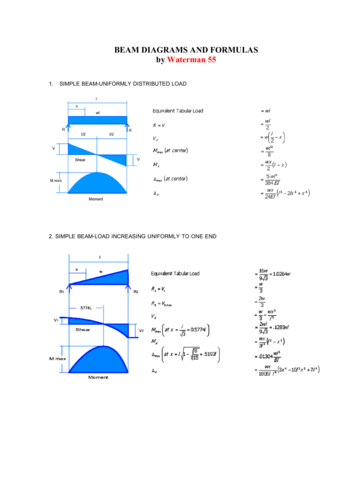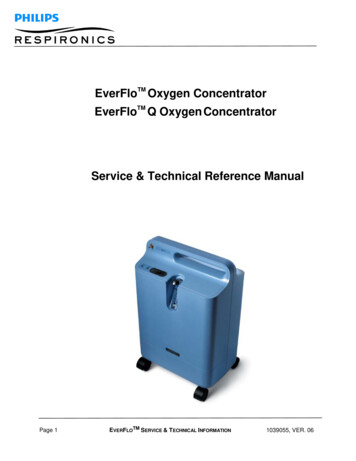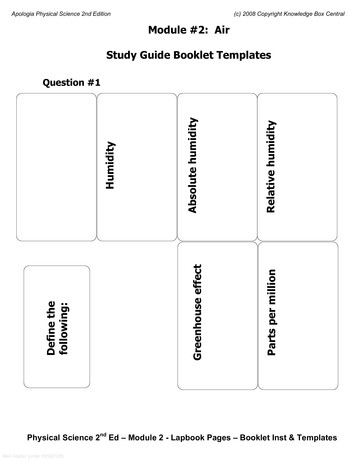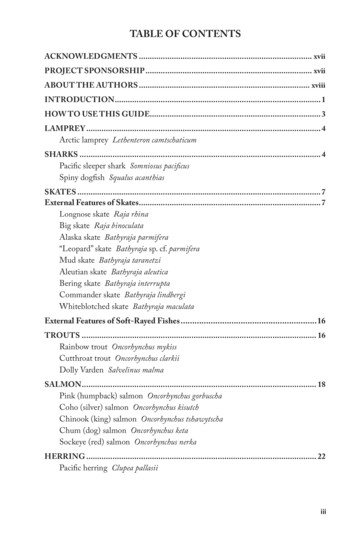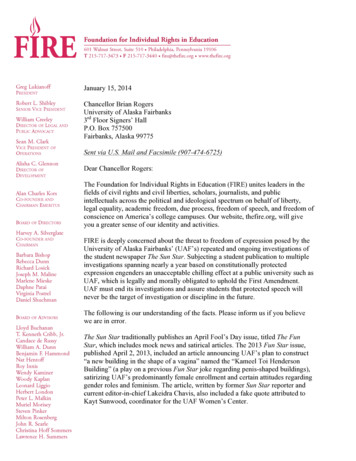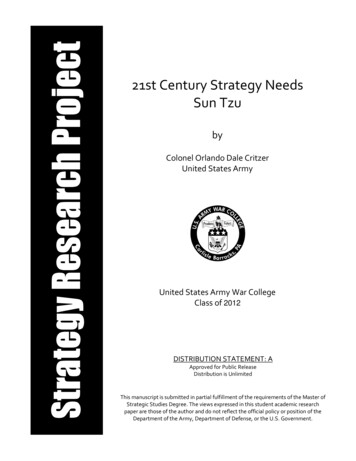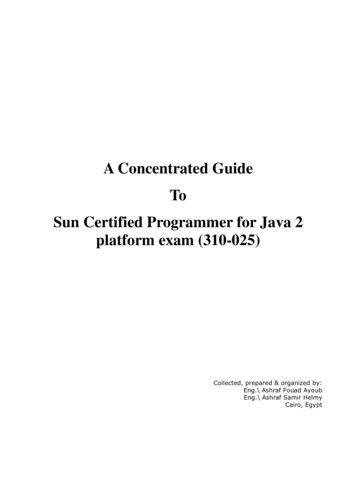
Transcription
A Concentrated GuideToSun Certified Programmer for Java 2platform exam (310-025)Collected, prepared & organized by:Eng.\ Ashraf Fouad AyoubEng.\ Ashraf Samir HelmyCairo, Egypt
Document version controlDate12/09/2001AuthorAshraf FouadVersion1.0 betaCommentCreationNote To Holders:If you receive an electronic copy of this document and print it out, please write your name onthe equivalent of the cover page, for document control purposes.If you receive a hard copy of this document, please write your name on the front cover, fordocument control purposes.
IntroductionTo all who downloaded this document, and preparing for sun certification programmer exam, Ithink this document will help you a lot, because:1- It collects its information mainly from the best 3 certification preparation books asmentioned by most certified individuals and previews in www.amazon.com :(a) “A programmer’s guide to Java Certification”(b) “The complete Java 2 certification study guide”(c) “Java 2 exam cram”2- Supplied with examples, diagrams.3- Supplied with tips for most common exam mistakes.4- Well organized as the exam objectives.5- Concentrate on the certification material, so you can study from it, and if you need toknow more about a topic or don’t have previous experience in it, you don’t have to buya certification book, but any Java book will do the trick.6- It was meant to be a complete document, no need for other, it target programmerswith min. 2 to 4 month of experience in java.7- Can be also used as a quick revision on the exam points as it is nearly 100 pages.8- Can be used as a course material for teaching courses in Java certification as I intend todo in my company.I (Ashraf Fouad) studied for the certification and passed the exam scoring 93%; nothing inthe exam was outside the document, but I think I needed to solve more exams than I did. Alsoone of my friends studied from it and scored 84% and he told me that nothing was neededmore than this document. I wish that as many can also contribute in supplying more tips thanI mentioned, so I intend to keep receiving comments from you till the end of this year beforemaking its final release.This document is supplied in .pdf format with the name scpj2vX.pdf where X indicatesdocument version number. It will come in a zip file named scpj2vX.zip in addition to a doc filenamed scpj2qavX.doc for my exam questions I met during preparation which I collected forthe following reasons:1- Hard or tricky question.2- It came in several exams so you must have an exercise on such question type.3- Type of question that you don’t expect to be asked in exam, but they ask, such asasking about Object Oriented concepts.Authors:Eng.\Ashraf Fouad AyoubWeb developerAlexandria UniversityFaculty of EngineeringDepartment of computer science andautomatic control(1999)Eng.\Ashraf Samir HelmyWeb developerAin Shams UniversityFaculty of EngineeringDepartment of computer and systemengineering(1999)For feedback, please mention the following:For correction:Mail To*: ashraf fouad76@yahoo.comMail subject*: SCPJ2 document correctionIn the mail body:Document version*: .Error in Tip number*: .Why error*: .Correction*: .Reference(If any): .If you wish your email is published among the contributors of the documents (Y/N): default (Y)
For commenting:Mail To*: ashraf fouad76@yahoo.comMail subject*: SCPJ2 document commentIn the mail body:Document version*: .Comment*: .If you wish your email & opinion is published among the previews of the documents (Y/N):default (Y), this will occur only when I make my site & this document will be part of it.For adding hints:Mail To*: ashraf fouad76@yahoo.comMail subject*: SCPJ2 document add hintsIn the mail body:Document version you have*: .Suggested chapter to add the hint*: .Hint*: .Reference*: .If you wish your email is published among the contributors of the documents (Y/N): default (Y)For receiving update of the document:Mail To*: ashraf fouad76@yahoo.comMail subject*: SCPJ2 document subscribe.The above are the minimum to send, send more and speak freely as you wish.For the questions document, I don’t want to receive more questions as the Internet is filledwith enormous already, but I can receive comments to be added for further declaration, or ifanyone doesn’t know explanation of the answers provided and needs more. So please followthe following direction for sending your comments about questions document.Mail To*: ashraf fouad76@yahoo.comMail subject*: SCPJ2QA documentIn the mail body:Document version*: .Question number*: .What is your question*: .Anything you want to add(If any): .Reference(If any): .If you wish your email is published among the contributors of the documents (Y/N): default (Y)Import Resources:One of the most important resources to me was www.yahoogroups.com, it contains severalgroups for java certification, I encourge subscribing in what you are interested in, but myadvice is to browse the mails through the web not to receive individual or digested mails,because they are very active groups. I mention hear their names and their description inyahoogroups, and I will keep always the newest version of this document on the files section ofjcertification group mentioned below.jcertification-subscribe@yahoogroups.comOnly e-Group for preparation of certification for java programmers. Experts for answering thequestions and discussions. Feel free to post your questions and get the best answers. Askanything regarding Java Certification. Register today and tell a friend about rt.com is an online study community for Sun's Java certification exams.sunjavacert-subscribe@yahoogroups.com
The list basically provides tips for Java aspirants. A list with information on Java Certification,SCJP, SCJA , SCJD , tips , books , tutorials, downloads, lists, mock and online exams. A listthat can give u that extra niche to get a high score in Java Certification.scjd-subscribe@yahoogroups.comThe main purpose of this list is to discuss issues/concerns/problems/solutions to your "SunCertified Java Developer" assignment.scjea-subscribe@yahoogroups.comThis mailing list will discuss the Sun enterprise architect exam using J2EE. This is a moderatedlist and any message not relevant to it would be deleted. Please check links page before youpost questions on the list. I have about 8 years experience in IT .I am a MCSD ( old and newcourse ) , SCJP 1.1 and SCJD 2.0 certified professional. Of all the exam I have given I foundthe SCJD 2.0 developer exam challenging and I am happy to inform you that I passed it withflying colors ( 149 / 155 marks ).java-dev-test-subscribe@yahoogroups.comWe are writing code to pass SCJD exam. Our members are from all over the world. We havethe best Java developer certification website on earth. We all work together to make tion/java/java on/javachina/Cert/FAQ p://www.go4java.20m.com/http://indigo.ie/ /www.javacaps.com/
Chapter 1:Language fundamentals
1.1)Java is case-sensitive. [3]1.2)Source file may contain ONLY ONE public class or interface, and any numbers ofdefault classes or interfaces. [3]1.3)If there is a public class or interface, the name of the source file must be the same asthe name of the class or interface. [3]1.4)The file name may begin with numbers if there is no public class on it. [3]1.5)If no package is explicit declared, java places your classes into a default package(Object). [3]1.6)Identifiers are composed of characters, where each character can be either letter(including Ŭ Ń ù Ă Ć Å), a connecting punctuation (underscore ) or any currencysymbol (such as ) and CANNOT start with a digit. [1]1.7)Keywords are reserved identifiers that are predefined in the language, and CANNOT beused to denote other entities. NOTE: None of the keywords have a capital letter.The following table denotes the currently defined keywords: [1] rnewswitchwhilestrictfpI found this in reference [8], but I didn’t find it in any certificationbook.The following table shows three reserved predefined literals: [9]nulltruefalseThe following table shows atorkeywords NOT currently in use: [9]outerrestvarI found this in reference [8], butI didn’t find it in any certificationbook.1.8)Integer literal by default is int, you can specify it as long by appending “L” or “l” assuffix, NOTE: THERE IS NO WAY to specify a short or byte literal. [1]1.9)Floating point literal by default is double, you can specify to be a float by appending“F” or “f” as suffix.[1]1.10) Octal numbers are specified with “0” as prefix, Hexadecimal numbers are specified with“0x” or “0X” as prefix.[1]1.11) Most important Unicode values: [1]Escape SequenceUnicode Value‘ �Z’\u005a‘a’\u0061CharacterSpace09AZa
‘z’\u007az1.12) Escape sequences are used to define special character values and can be representedalso in Unicode value, the following table shows them: [1]Escape SequenceUnicode ValueCharacter\b\u0008Backspace\t\u0009Horizontal tabulation\n\u000aLinefeed\f\u000cForm feed\r\u000dCarriage n mark\\\u005cBackslash\xxxA character in octalrepresentation; xxx mustrange between 000 and337\uxxxxA unicode character,where xxxx is ahexadecimal formatnumber.1.13) The single apostrophe ‘ need not to escaped in Strings, but it would be if specified as acharacter literal ‘\’’. [1] [8]Example:String tx “Delta values are labeled \”\u0394\” on the chart.”;1.14) Regardless of the type of comment, it can’t be nested. [1]1.15) Default values for member variables table: [1]Data typeDefault valuefalseboolean‘\u0000’char0Integer(byte, short, int, long) 0.0F or 0.0DFloating-point(float, double)nullObject reference1.16) static variables in a class are initialized to default values when class is loaded if theyare not explicitly initialized. [1]1.17) Instance variables are initialized to default values when the class is instantiated if theyare not explicitly initialized. [1]1.18) Local variables (Automatic) are NOT initialized when they are instantiated at methodinvocation. The compiler javac reports use of uninitialized local variables. [1]1.19) There can be ONLY one package declaration in a Java file, and if it appears, it must bethe first non-comment statement. [8]1.20) The JVM expects to find a method named main with the signature as follows: [8]public static void main(String[] args)The array is typically named args, but it could be named anything.NOTE:You can have methods named main that have other signatures. The compiler willcompile these without comment, but the JVM will not run an application that does nothave the required signature.
Chapter 2:Operator and assignments
2.1)Operator precedence and associativity: [1]Postfix operators[] . (parameters) expression expression-Prefix unary operators expression --expression expression –expression !Object creation and cast new (type)* / %Multiplication Addition Shift instanceofRelational operators ! Equality operators&Bitwise/Logical AND Bitwise/Logical XOR Bitwise/Logical OR&&Logical AND Logical OR?:Conditional operator - * / % & Assignment2.2)Casting between primitive values and references CANNOT be applied. [1]2.3) (Bit wise inversion) convert all 1’s to 0’s and vise versa. [3]2.4)The modulo operator % give the value of the remainder of the division of the leftoperand (dividend) by the right operand (divisor). [3] [8]2.5)A useful rule to calculate the modulo: Drop any negative sign from the operands,calculate the modulo, then the result sign is relative to the left operand (dividend). [3]Example:int x -5 % 2;// x -1int y -5 % -2;// y -1int z 5 % -2;// z 12.6) and && work with boolean not with integers like & and , and the result from - & isint. NOTE: & and are used with both boolean and integers. [3]2.7)Unlike in C, integers in Java can NEVER be interpreted as boolean values, soexpressions used for flow control MUST evaluate to boolean. [8]2.8)The conditional assignment operator, the ONLY Java operator that takes threeoperands:? [1] [3] [8] condition ? expression1 : expression2 Example:String x (salary 1500)? “Poor”: ”Not poor”;String y (salary 1500)? "Poor": (salary1 10)? "poor1":"poor2";2.9)Multiple assignment: [1]k j 10; // (k (j 10))2.10) Boolean values CANNOT be casted to other data values, and vice versa, the sameapplies to the reference literal null, which is NOT of any type and therefore CANNOTbe casted to any type. [1]2.11) Conversion is done when: [8](a) Assigning a value to a primitive variable.(b) Evaluating arithmatic expressions.(c) Matching the signature of methods.Example:The Math class has max and min methods in several versions, one for each of int,long, float, double. Therefore, in the following code that calls Math.max with
one int and one long in line 3, the compiler converts the int primitive to a longvalue. The alternative in line 4 forces the compiler to cast the value n to an intand calls the version of max that uses two int primitives.int m 93;//(1)long n 91;//(2)long x Math.max(m, n);//(3)int y Math.max(m, (int) n);//(4)2.12) Widening primitive conversion is as follows (it doesn’t lose information about themagnitude of a value), and any other conversion is called narrowing primitiveconversion and may cause lose of information. At runtime, casts that lose informationdo not cause a runtime excpetion, and it is up to the programmer to think through allthe implications of the cast. [1] [8]2.13) Integers of int (32-bit) or smaller can be converted to floating-point representation,but because a float also uses only 32 bits and must include exponent information,there can be a loss of precision. [8]2.14) All six numbers types in Java are signed meaning they can be negative or positive. [3]2.15) The ONLY integer primitive that is not treated as a signed number is char, whichrepresents a Unicode character. [8]2.16) All conversion of primitive’s data types take place at compile time. [3]2.17) Arithmetic operations:(a) For unary operators if byte – short - char Æ converted to int.(b) For Binary operands:1. If one of operands is double the other operand is converted to a double.2. If one of the operand is float, the other operand is converted to float.3. If one of the operand is long, the other operand is converted to long.(c) Else both the operands are converted to int.2.18) Ranges of primitive dataTypeBits ble 648types: [1] [3]Minimum .94065645841246544e-324Maximum range27 – 1215 – 1\uFFFF231 – 1263 – 13.40282346638528860e 381.79769313486231570e 3082.19) Depending on the storing type of the arithmetic operation the precision is done. [3]Example:int x 7/3;// x 2byte b 64; b * 4; // b 02.20) The compiler pays attention to the known range of primitives. [8]Example:int n2 4096L;// (1) would require a specific (int) castshort s1 32000; // (2) OKshort s2 33000; // (3) out of range for short primitive
In spite the fact that 4096 would fit in an int primitive, the compiler will object on thefirst line because the literal is in long format.You could force the compiler to accept line 3 with a specific (short) cast, but the resultwould be a negative number due to the high bit being set.2.21) Important examples for arithmetic expression evaluation: [1]Arithmetic ExpressionEvaluationResult when printed4/0Arithmetic Exception4.0/0.0(4.0/0.0)POSITIVE INFINITY-4.0/0.0((-4.0)/0.0)NEGATIVE INFINITY0.0/0.0(0.0/0.0)NaN2.22) NaN can result from mathematical functions that are undefined, such as taking thesquare root of a negative number. In float to double conversion, if the float has oneof the special values, NaN, POSITIVE INFINITY, or NEGATIVE INFINITY, the double endsup with the corresponding double special values. [8]2.23) Float.NaN, Double.NaN are considered non-ordinal for comparisons, this means all thatare false: [3]x Float.NaNx Float.NaNBut you can test by Float.isNaN(float f), Double.isNan(double d).2.24) While casting special floating-point values, such as NaN, POSITIVE INFINITY to integervalues, they will be casted without any complaint from the compiler or an exception. [8]2.25) variable op expression is equivalent to variable ( variable type ) ( variable operator ( expression )). [1]2.26) short h 40;// OK, within rangeh h 2;// Error can’t assign int to shortSolution for the above situation, choose one of the following: [1]h (short) (h 2);h 2;NOTE:h h (short)2;// Requires additional castingWill not work because binary numeric promotion leads to an int values as result ofevaluating the expression on the right-hand side.2.27) System.out.println(“We put two and two together and get ” 2 2);Prints: We put two and two together and get 22NOT: We put two and two together and get 4Declaration: (((“We put two and two together and get ”) 2) 2). [1]2.28) If your code conducts operations that overflow the bounds of 32-bit or 64-bit integerarithmatic, that’s your problem, i.e. Adding 1 to the maximum int value 2147483647results in the minimum value –2147483648, i.e. the values “wrap-around” for integers,and no over or underflow is indicated. [1] [8]2.29) The dot operator has left associativity, in the following example the first call of themake() returns an object reference that indicates the object to execute the next call,and so on [1]SomeObjRef.make().make().make();2.30) To get the 2’s complement: [3](a) Get the 1’s complement by converting 1’s to 0’s and 0’s to 1’s.
(b) Add 1.2.31) In the left shift operator all bytes are moved to the left the number of places youspecify, and zero is padded from the right. [6]2.32) Signed right shift and unsigned right shift work identically for positive numbers,in operator zeros fill the left most bits, but in will propagate the left most onethrough the rest of bits. [6]2.33) When you shift a bit by a numeric value greater than the size in bits, Java does amodulas shift. [6]2.34) To shift a negative number get the 2’s complement and then shift it. [3]2.35) Object reference equality ( , ! ): [1]The equality operator and the inequality operator ! can be applied to objectreferences to test if they denote the same object. The operands must be typecompatible, i.e. It must be possible to cast one into the other’s type, otherwise it is acompile time error.Example:Pizza pizza A new Pizza(“Sweat & Sour”);Pizza pizza B new Pizza(“Hot & Spicy”);Pizza pizza C pizza A;String banner “Come and get it”;boolean test banner pizza A;boolean test1 pizza A pizza B;boolean test2 pizza A pizza C;// Compile time error// false// true2.36) The equals method: [8]In the Java standard library classes, the method that compares content is alwaysnamed equals and takes an Object reference as input. It does not look at the value ofthe other object until it has been determined that the other object reference is not nulland that it referes to the same type, else it will return false.NOTE:The equals method in the Object class returns true ONLY IFthis objso in the absence of an overriding equals method, the operator and equals methodare equivalent.2.37) Using instanceof: if the right-hand operand that MUST name a reference type mayequally will be an interface; In such case the test determines if the object at the lefthand argument that MUST be a name of a reference variable implements the specifiedinterface. [3] [8]2.38) If we compare an object using instanceof and the class we compare with is not in thehierarchy this will cause compiler error, (Must be on the hierarchy above or bottom theclass). We can overwrite the problem of compiler error caused by instanceof bydeclare the class from the Object class. [3]Example:Object x new Button();2.39) Object reference conversion take place at compile time because the compiler has all theinformation it needs to determine whether the conversion is legal or not. [3]2.40) Short circuit evaluation: [1] [8]
In evaluation of boolean expression involving conditional AND && or OR , the leftoperand is evaluated before the right one, and the evaluation is short circuited, i.e.: ifthe result of the boolean expression can be determined from the left-operand, the righthand operand is not evaluated.NOTE:when bitwise AND & or bitwise OR are used in a boolean expression, both operandsare evaluated, and NO short circuit evaluation is applied.2.41) Parameter passing: All parameters are passed by value. [1]Data type of the formal parameterValue passedPrimitive data typesPrimitive data valueClass typeReference valueArray typeReference value2.42) A formal parameter can be declared with the keyword final preceding the parameterdeclaration. A final parameter is also known as blank final variable, i.e. it is blank(uninitialized) until a value is assigned to it at method invocation. [1]Example:public static void bake(final Pizza pizzaToBeBaked) {pizzaToBeBaked.meat “chicken”;// AllowedpizzaToBeBaked null;// Not Allowed}
Chapter 3:Declarations and Access Control
3.1) Arrays are a special kind of reference type that does not fit in the class hierarchy but canalways be cast to an Object reference. Arrays also implement the Cloneable interface andinherit the clone method from the Object class, so an array reference can be cast to aCloneable interface. [8]3.2) Array declaration and constructor: elementType1 arrayName [] new elementType2 [numberofelements];Note: elementType2 must be assignable to elementType1 , i.e.: class or subclass of elementType1 , and when the array is constructed, all its elements are initialized tothe default value for elementType2 , WHATEVER the array is automatic variable ormember variable. [1] [3]3.3) When constructing multi-dimensional arrays with the new operator, the length of thedeeply nested arrays may be omitted, these arrays are left unconstructed. [1]Example:double matrix[][] new double[3][];3.4) length of array object is a variable NOT a method. [3]3.5) It is legal to specify the size of an array with a variable rather than a literal. [3]3.6) The size of the array is fixed when it is created with the new operator or with specialcombined declaration and initialization. [8]3.7) Anonymous arrays: [1]new elementType [] { initialization code }Example of usage:class AnonArray {public static void main(String[] args) {System.out.println(“Minimum value ” findMin(new int[] {3,5,2}));}public static int findMin(int[] dataSeq) {int min dataSeq[0];for (int index 1; index dataSeq.length; index ) {if (min dataSeq[index])min dataSeq[index];}}}3.8) There is NO way to ‘bulk’ initialize an array, if you want to initialize array to certain valueduring declaration you MUST iterate with the value you want. NOTE: Intialization bymeans of a bracketed list can be used only in the statement that declares the variable. [8]3.9) It is possible to create arrays of zero length of any type, a common natural occurrence ofan array of zero length is the array given as an argument to the main() method when aJava program is run without any program arguments. [1]3.10) Primitive arrays have no hierarchy, and you can cast a primitive array reference ONLYto and from an Object reference. Converting and casting array elements follow thesame rules as primitive data types. Look to the strange LEGAL syntax for casting anarray type as shown in line 3 in the following example. [8]int sizes[] {4, 6, 8, 10}; //(1)Object obj sizes;//(2)int x ((int[])obj)[2];//(3)
3.11) Casting of arrays of reference types follows the same rules as casting single references.NOTE that an array reference can be converted independantly of whether or not thearray has been populated with references to real objects.[8]Example:Suppose you have a class named Extend that extends a class named Base. You couldthen use the following code to manipulate a reference to an array of Extend references:Extend[] exArray new Extend[20];Object[] obj exArray;Base[]bArray exArray;Extend[] temp (Extend[])bArray;3.12) An import declaration does not recursively import sub-packages. [1]3.13) The order of modifiers in class declaration: [3](a) public.(optional)(b) final or abstract. (CANNOT appear together)(c) class.(mandatory)(d) classname.(mandatory)(e) extends.(optional)(f) superclassname.(mandatory if extends specified)(g) implements.(optional)(h) interfacelist.(mandatory if implements specified)(i) {}.(mandatory)3.14) If the access modifier is omitted (package or default accessibility), in which case theyare only accessible in the package but not in any sub-packages. [1]3.15) The ONLY access modifier allowed to the top level class is public or friendly. [3]3.16) abstract modifier implies that the class will be extended, but abstract class CANNOTbe instantiated. [3]3.17) The compiler insists that a class that has an abstract method must be declaredabstract, and this forces its subclasses to provide implementation for this method, andif a subclass does not provide an implementation of its inherited methods must bedeclared abstract. [1]3.18) it is NOT a MUST for an abstract class to have a abstract method. [10]3.19) Interfaces as classes CANNOT be declared protected, private, native, static,synchronized. [3] [8]3.20) An interface is different from a class in also it can extend MORE than one interface, thisfollows from the fact that a class can implement more than one interface. [8]Example:public interface RunObs extends Runnable, ObserverAny class implementing this interface will have to provide methods required by bothRunnable and Observer.3.21) The order of modifiers in method declaration: [3](a) public or private or protected.(optional for package declaration)(b) abstract or final or native or static or synchronized.(optional)(c) returntype.(mandatory)(d) methodname.(mandatory)(e) throws clause.(optional)(f) {}.(mandatory)
3.22) abstract methods or methods defined in an interface must end with ‘;’. (i.e. abstractmethod is non-functional methods that haven’t body), and abstract methods declaredONLY on interface or abstract classes. [3]3.23) The class must be declared abstract if: [3](a) The class has one or more abstract methods.(b) The class inherits one or more abstract methods (from an abstract parent) for whichit doesn’t provide implementation for one or more of the abstract methods of theparent class.(c) The class declares that it implements an interface but doesn’t provide implementationfor EVERY method of that interface.3.24) When abstract class implement interface there is no need to this class to implement allmembers of the interface. [3]3.25) Interfaces just specify the method prototypes and not the implementation; they are bytheir nature, implicitly abstract, i.e. they CANNOT be instantiated. Thus specifying aninterface with the keyword abstract is not appropriate, and should be omitted, but itwon’t give compile error if specified. [1]3.26) final classes CANNOT be extended. Only a class whose definition is complete (i.e. hasimplementation of all the methods) can be specified to be final. [1]3.27) The order of modifiers in variable declaration: [3](a) public or private or protected.(optional)(b) final or static or transient or volatile. (optional)(c) variable type.(mandatory)(d) variable name.(mandatory)3.28) Within a class definition, reference variables of this class’s type can be used to accessall NOT INHERITED members regardless of their accessibility modifiers. [1]Example:Class Light {// Instance variablesprivate int noOfWatts;private boolean indicator;private String location;public void switchOn() {indicator true;}public void switchOff() {indicator false;}public boolean is On() {return indicator;}public static Light duplicate (Light oldLight) {Light newLight new Light();newLight.noOfWatts oldLight.noOfWatts;newLight.indicator oldLight.indicator;newLight.location new String(oldLight.location);}}3.29) ONLY variables, methods and inner classes may be declared protected. [3]3.30) static members can be called from the member objects. [3]Example:this.xyzNOTE:The use of this MUST be from a non-static method, or “this cannot be referenced froma static context” compiler error will be thrown.
3.31) Trying to use object class member before the constructor of the object class membercalled will compile fine but will give NullPointerException. [3]Example:public class Trial {static Date d ;public static void main (String args[]) {System.out.println( d.getYear() );}}3.32) In local object if u try to check null of a local object before the initialize of it is called will cause compilation error that variable might not have been initialized, you canoverwrite this problem by initializing an object with null value. [3]AccessModifierIts lass inSamePackageYesYesYesNoS
mentioned by most certified individuals and previews in www.amazon.com : (a) fiA programmer s guide to Java Certificationfl (b) fiThe complete Java 2 certification study guidefl (c) fiJava 2 exam cramfl 2- Supplied with examples, diagrams. 3- Supplied with tips for most common exam mistakes. 4- Well organized as the exam objectives.

